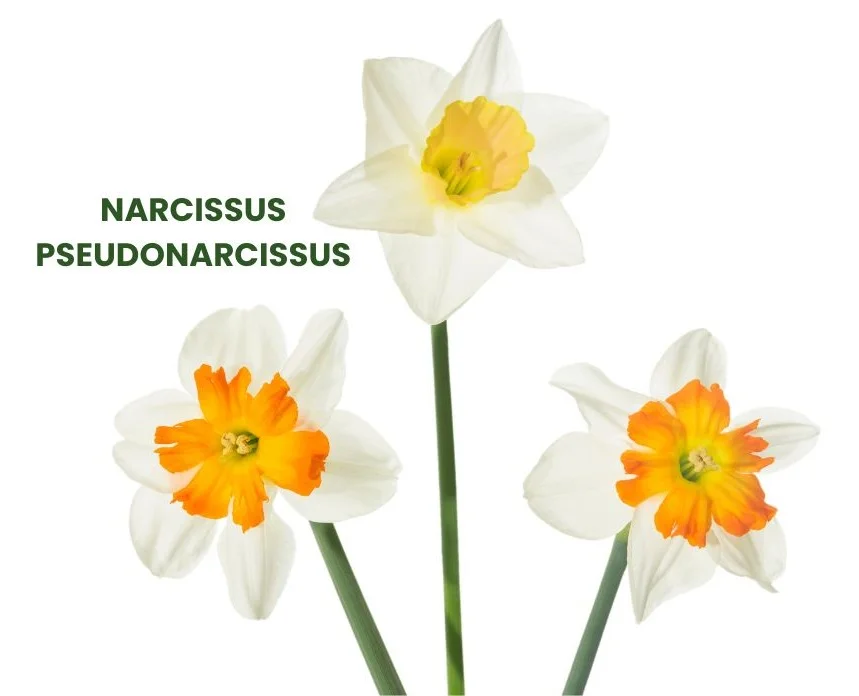Narcissus pseudonarcissus, commonly known as Daffodil, is a plant native to Europe and widely recognized for its beautiful, vibrant flowers.
This plant has been utilized for its medicinal properties despite its toxic nature when consumed in large quantities.
In homeopathy, Daffodil bulbs are employed for their therapeutic effects on the gastrointestinal, respiratory, and skin systems.
This versatile remedy is known to address symptoms such as nausea, vomiting, diarrhea, persistent cough, bronchitis, and various skin conditions.
The alkaloid content in the bulbs, which varies before and after flowering, contributes to its diverse effects, making it a valuable remedy for a range of ailments.

SOURCE INFORMATION
Scientific Classification
- Kingdom: Plantae
- Clade: Angiosperms
- Order: Asparagales
- Family: Amaryllidaceae
- Genus: Narcissus
- Species: N. pseudonarcissus
Origin and Historical Facts
- Commonly known as Daffodil, this plant is native to Europe but widely cultivated around the world for its attractive flowers.
- Historically, Daffodil bulbs have been used for their medicinal properties, despite their toxic nature when ingested in large quantities.
DRUG PATHOGENESIS
- Narcissus pseudonarcissus exerts its therapeutic effects primarily on the gastrointestinal system, respiratory system, and skin.
- It addresses symptoms such as nausea, vomiting, diarrhea, cough, and skin eruptions.
KEY CHARACTERISTICS
GASTROINTESTINAL SYMPTOMS
- Nausea and Vomiting: Intense feelings of nausea followed by violent episodes of vomiting.
- Diarrhea: Accompanying the vomiting, the patient experiences severe diarrhea.
ALKALOID EFFECTS
The effects of the alkaloid vary depending on whether it is extracted from the flowering bulb or post-flowering bulb.
From Flowering Bulb
- Dryness of the mouth
- Reduced skin secretions
- Pupil dilation
- Increased pulse rate
- Slowed and weakened heart contractions
From Post-Flowering Bulb
- Copious salivation
- Increased skin secretions
- Pupil contraction
- Slight relaxation of the pulse
- Mild faintness and nausea
RESPIRATORY SYMPTOMS
- Cough and Bronchitis: Persistent cough that can lead to bronchitis.
- Coryza: Inflammation of the mucous membranes in the nose, often leading to a runny nose and sneezing.
- Frontal Headache: Pain concentrated in the forehead area, often associated with respiratory symptoms.
- Whooping-Cough: Effective during the convulsive stage of whooping-cough.
SKIN SYMPTOMS
- Erythema: Redness of the skin, which can manifest as papular (small raised bumps), vesicular (small blisters), or pustular (pus-filled lesions).
- Aggravation in Wet Weather: Skin symptoms worsen in damp or rainy conditions.
MODALITIES
- Worse: Wet weather
- Better: Dry conditions
WHAT ARE MODALITIES IN HOMOEOPATHY?
RELATIONSHIP WITH OTHER DRUGS
- Narcissus pseudonarcissus does not have widely documented relationships with other specific homeopathic remedies, but it is used for similar conditions as other remedies for nausea, vomiting, and respiratory issues.
DOSE
- Potency: Typically prescribed in the first attenuation.
- Administration: Dosage and frequency should be determined by a qualified homeopathic practitioner based on individual symptoms and response.
Frequently Asked Questions (FAQs)
What conditions can Narcissus pseudonarcissus treat?
- It is used for nausea, vomiting, diarrhea, cough, bronchitis, frontal headache, and skin conditions like erythema.
How does the alkaloid in Narcissus pseudonarcissus vary in effect?
- The alkaloid extracted from the flowering bulb causes dryness of the mouth, reduced skin secretions, pupil dilation, and increased pulse rate.
- In contrast, the alkaloid from the post-flowering bulb leads to increased salivation, skin secretions, pupil contraction, and mild faintness and nausea.
What are the key symptoms indicating the need for this remedy?
- Severe nausea followed by vomiting and diarrhea, persistent cough, bronchitis, frontal headache, and skin eruptions that worsen in wet weather.
What potency is commonly used for this remedy?
- The first attenuation is typically used for this remedy.
Meaning of Difficult Words
- Nausea: Feeling of sickness with an inclination to vomit.
- Diarrhea: Frequent and watery bowel movements.
- Coryza: Inflammation of the mucous membranes in the nose.
- Frontal Headache: Pain in the forehead region.
- Erythema: Redness of the skin due to increased blood flow.
- Papular: Referring to small, raised bumps on the skin.
- Vesicular: Referring to small blisters.
- Pustular: Referring to lesions filled with pus.
- Attenuation: A homeopathic preparation method where the substance is diluted.
